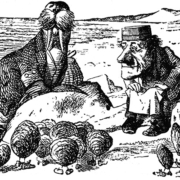On the Virtue of Temperance
“The time has come,” the Walrus said,
“To talk of many things:
Of shoes–and ships–and sealing-wax–
Of cabbages–and kings–
And why the sea is boiling hot–
And whether pigs have wings.”
– Lewis Carroll, Through the Looking-Glass, and What Alice Found There (1871)
Self-restraint is a key behaviour to cultivate in technology consulting work. This may be a natural strength for some but for me it definitely isn’t and is something I try to work on.
Rush to judgment
The temptation to offer an undercooked point of view (hot-take) is ever-present and highly seductive.
The argument for judiciousness is self-evident but worth setting out. Simply put, if professional advice is what I’m selling, that is what I need to provide. Professional advice. And however we want to define or characterise professional, it is surely the antithesis of my off-the-cuff ‘reckon’.
Telling tales
Restraining oneself from offering firm opinions and advice too early is essential and obvious. However, there is a stronger and more complex species of restraint required.
The quote above is from a poem called The Walrus and the Carpenter. In the poem the Walrus and Carpenter entreat young Oysters to follow them with the promise of a “pleasant walk and pleasant talk”. The end-game however, unfortunately for the Oysters, is lunch. It’s a little ambiguous though whether eating the oysters was the conscious intention of the storytellers at the time of the invitation.

Image by Morphart Creation via Shutterstock
The stronger restraint I’m after is the ability to resist a similar storytelling impulse. It is insidiously tempting to prematurely begin to tell stories that frame the issue or solutions, to seduce and beguile like the Walrus. This can even happen unconsciously in my experience. And if allowed to proceed unconsciously, the stories you tell will be influenced by those same undercooked preliminary conclusions that we wanted to protect the client from.
Just as for the Walrus, it’s likely that such stories turn out to be self-interested or biased. If not quite as blatantly self-serving they can be influenced by biases towards or away from particular technologies. Such biases aren’t bad per se, they likely represent solid heuristics informed by experience. But even so those biases must be acknowledged and challenged in practice.
For me this story-telling temptation is motivated by a desire to please, or to sound clever and quick. This is obviously toxic and unhelpful. The behavioural circuit that I want to cultivate instead is one that suppresses the fear of saying “I don’t know [yet]”. In fact to take professional pride in it. This has become one of the traits I most admire in consultants I work with. The best can always (and in any company) fearlessly make a confession of ignorance or indeterminacy and firmly stick a full-stop at the end of it.
The Experience trap
This can actually get harder with experience. It can make reliably finding the right level of restraint even more challenging.
With competence and fluency in a topic you feel comfortable, you ask great questions and cut to the heart of issues quickly. It’s a fantastic feeling and we definitely want to provide our clients all the benefits of our experience, including potentially the benefit of a conclusion more quickly.
The problem is overconfidence, re-enforced by confirmation bias. The tendency is to over-emphasise aspects of the problem or situation that are familiar, matching prior experiences and expectations. Have we spent enough time searching out and weighing unfamiliar features of the situation, the things that make it unique.
A System Solution
For me the confidence to be appropriately judicious is best built on top of checks baked into the process or system I apply to a piece of work. That process/system should evoke confidence that it will produce the best answers possible with the resources available and other limitations (including my ability). A good process should produce answers that are as free from bias as possible, and which speak directly to the client’s needs.
The process design will of course vary based on circumstances and type of work but the common feature that will reliably promote the right type of restraint is a system of review or audit.
The approach I favour and am experimenting with is to identify up-front for each piece of work, a balance of independent, self, and peer review that is appropriate to the work and is practical given the resources available.
Conclusion
As a professional giver of advice the integrity and quality of that advice is essential. Achieving this must mean amongst other things, taking the time to get it right. It can be difficult, but it’s a battle worth waging.
Just ask those Oysters.

